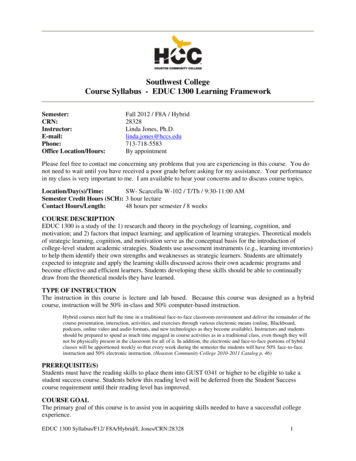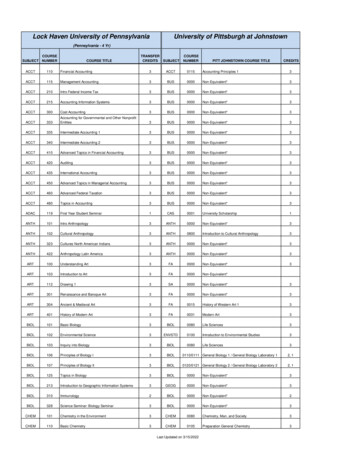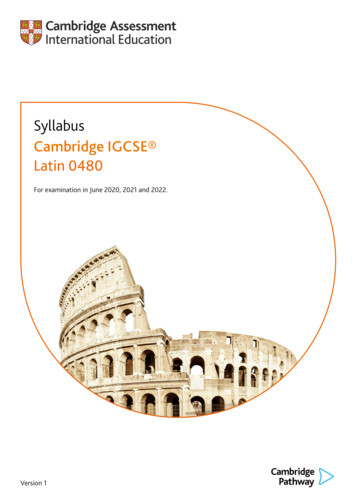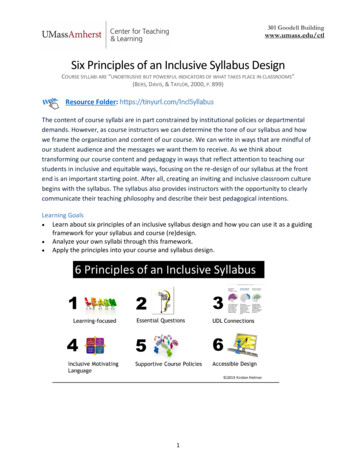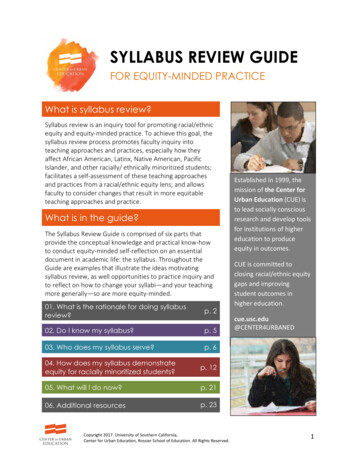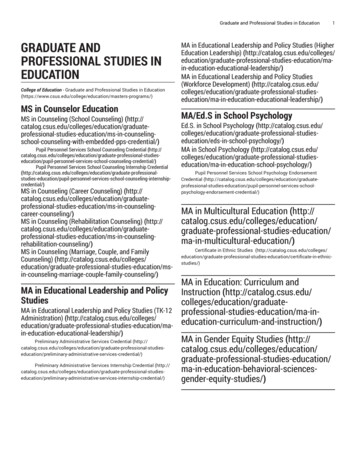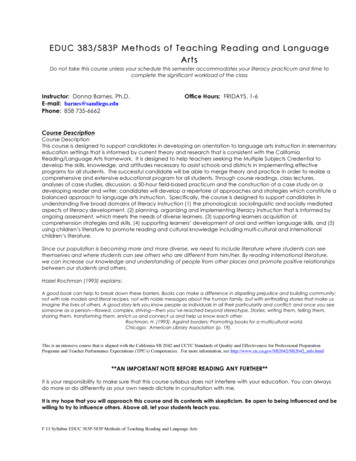
Transcription
EDUC 383/ 583P Methods of Teaching Reading and LanguageArtsDo not take this course unless your schedule this semester accommodates your literacy practicum and time tocomplete the significant workload of the classInstructor: Donna Barnes, Ph.D.E-mail: barnes@sandiego.eduPhone: 858 735-6662Office Hours: FRIDAYS, 1-6Course DescriptionCourse DescriptionThis course is designed to support candidates in developing an orientation to language arts instruction in elementaryeducation settings that is informed by current theory and research that is consistent with the CaliforniaReading/Language Arts framework. It is designed to help teachers seeking the Multiple Subjects Credential todevelop the skills, knowledge, and attitudes necessary to assist schools and districts in implementing effectiveprograms for all students. The successful candidate will be able to merge theory and practice in order to realize acomprehensive and extensive educational program for all students. Through course readings, class lectures,analyses of case studies, discussion, a 50-hour field-based practicum and the construction of a case study on adeveloping reader and writer, candidates will develop a repertoire of approaches and strategies which constitute abalanced approach to language arts instruction. Specifically, the course is designed to support candidates inunderstanding five broad domains of literacy instruction (1) the phonological, sociolinguistic and socially mediatedaspects of literacy development. (2) planning, organizing and implementing literacy instruction that is informed byongoing assessment, which meets the needs of diverse learners. (3) supporting learners acquisition ofcomprehension strategies and skills. (4) supporting learners’ development of oral and written language skills, and (5)using children’s literature to promote reading and cultural knowledge including multi-cultural and internationalchildren’s literature.Since our population is becoming more and more diverse, we need to include literature where students can seethemselves and where students can see others who are different from him/her. By reading international literature,we can increase our knowledge and understanding of people from other places and promote positive relationshipsbetween our students and others.Hazel Rochman (1993) explains:A good book can help to break down these barriers. Books can make a difference in dispelling prejudice and building community;not with role models and literal recipes, not with noble messages about the human family, but with enthralling stories that make usimagine the lives of others. A good story lets you know people as individuals in all their particularity and conflict; and once you seesomeone as a person—flawed, complex, striving—then you’ve reached beyond stereotype. Stories, writing them, telling them,sharing them, transforming them, enrich us and connect us and help us know each other.Rochman, H. (1993). Against borders: Promoting books for a multicultural world.Chicago: American Library Association (p. 19).This is an intensive course that is aligned with the California SB 2042 and CCTC Standards of Quality and Effectiveness for Professional PreparationPrograms and Teacher Performance Expectations (TPE’s) Competencies. For more information, see http://www.ctc.ca.gov/SB2042/SB2042 info.html**AN IMPORTANT NOTE BEFORE READING ANY FURTHER**It is your responsibility to make sure that this course syllabus does not interfere with your education. You can alwaysdo more or do differently as your own needs dictate in consultation with me.It is my hope that you will approach this course and its contents with skepticism. Be open to being influenced and bewilling to try to influence others. Above all, let your students teach you.F 11 Syllabus EDUC 383P-583P Methods of Teaching Reading and Language Arts
Required Reading:Basic Reading Inventory: Pre-Primer Through Grade Twelve And Early Literacy Assessments by Jerry L. JohnsImproving Reading: Strategies and Resources by Jerry Johns and Susan Davis Lenski.Preparation Guide for the California RICA, and a Guideline for Reading Instruction in Grades Kindergarten to Eight(Paperback)by Marilyn Dye (Author), Marlene Giles (Author) THIS IS THE BOOK I WANT TO USE, BUT IT IS OUT OF PRINT. I HAVE TOFIGURE OUT WHICH OTHER BOOK I’D LIKE US TO USE .NOTHING HAS BEEN ORDERED THROUGH THE BOOKSTORE.Optional: Building a Knowledge Base in Reading by Jane Braunger and Jan Lewis. THIS IS AN EXCELLENT BOOK!California Reading/Language Arts Framework available online ; scroll down to the sub-heading Reading/Language ArtsFramework and click on the View The Framework (PDF) file.love that dog by Sharon Creech—these books will be distributed and paid for in class.Buy one other children’s book to use in a literature circle. The titles will be shared in class and you will be asked tomake a 1st, 2nd, and 3rd choice. I haven’t finalized the book titles, but some of the possibilities include: Flipped, Honusand Me, Stargirl, Bridge to Terabithia, Number the Stars, and Our Stories, Our Songs: African Children Talk aboutAIDS, Granny Torrelli Makes Soup, Missing May, Because of Winn Dixie, Hunger Games. I will need to learn whatbooks you’ve read.Books, materials, and guest speaker fees: 30.00. Please pay in class.I sat down and thought about what I thought was very important for you to know and be able to do at the end ofthis class and here’s what I wrote:1.2.3.4.5.6.7.It’s very important for you to build your relationships with your students and manage your classroom in away that promotes the creation of a “community of learners”.Understand the importance of predictability as a growing reader (which we all are) and how it helps us interms of navigating our way in the world.Understand the importance of background knowledge and of relating “new information” to oldinformation” when trying to engage students and promote their comprehension.Have strategies for creating a learning environment where not all students are doing the same thing at thesame time and where choice and variety are an integral part of your commitment to your students.Learn how to assess students’ knowledge and skills and then use that information to inform your practice.Allow the students to teach you. Listen, observe, notice responses from your students, and they will teachyou what’s “comprehensible”, effective, helpful and engaging.Develop or continue to develop your interest, commitment and love for literature, not only for the literatureitself, but also so that you can recommend books/poetry to students.Others:THOSE ARE THE TOP EIGHT*Learn the language of our discipline (Learn the Lingo)* Understand the reasons for and the effects of ability grouping* Learn the IMPORTANCE of reading aloud and becoming an “effective reader”.* Learn how to use Learning CentersRELAX AND ENJOY YOUR STUDENTSCourse Requirements—In most cases, MOST ALL of your work will be submitted to me at my g-mailaddress. You’ll need to know how to scan and post your work. You will have to submit your case study,EDUC 383P/583P Methods of Teaching Reading and Language Arts Spr 112
which is your “embedded signature assignment” in this course, via Taskstream and must “join” if youhaven’t.1.Attendance, Preparation and Participation: ATTEND ALL CLASSES; arrive on time or early and activelyparticipate in class. One of my doctoral students tells his students in theatre that, “if you’re on time, you’re late.” Ifyou miss class, you miss collaborative activities and discussions that cannot be “made up”. Should an emergencyarise, it is your responsibility to e-mail or call me in advance to advise me of your absence and to makearrangements with another student to find out what you missed. More than one absence from this course willjeopardize your successful completion of the class. Do all assigned reading before class. Underline in your books andon your articles, write comments and questions in margins. DO NOT try to complete any assignments (reading orotherwise), which are due during class time!!2.Successfully complete a 50-hour practicum. This is one of the most important parts of your learning—you willprobably enjoy this part of the class more than anything else! You will get to know a group of students and yourpracticum teacher. You will conduct an in-depth case study and work with small and large groups of students. Youwill be expected to implement a minimum number of lessons in your practicum including at least one lesson in theareas of: reading, writing, phonics, and oral language. Other possibilities include, but are not limited to: drama,reader’s theatre, Newspapers in Education, poetry, choral reading, storytelling, speech making, responses toliterature, development of learning centers, word study, and/or spelling. You may develop these lessons on yourown or in conjunction with your classroom teacher. Your practicum teacher will take notes on one of your lessonsand your practicum supervisor will observe a total of two lessons. You will turn in the written notes they take duringthese observations. Your practicum hours must take place during the classroom’s literacy time (usually in themornings) and you must be at the classroom at least two days per week for 6-12 weeks. Splitting time between twoor more classrooms does not fulfill this course requirement. See STUDENT REQUIREMENTS FOR THE PRACTICUM IN YOURPRACTICUM STUDENT HANDBOOK for further details.3.Design and write a lesson plan that must be submitted for feedback to me before implementation. Afteryou receive feedback on your rough draft, you can choose to revise the lesson or not based on your best judgment.Implement the lesson. Respond to how you think the lesson went, and turn in your original plan as well as the revisedversions of your lesson. On the revised version of your lesson, use BOLD PRINT to indicate where you made revisions(parts that are different from your original rough draft). If you did not revise, make a note of that.4.Plan and (hopefully) implement a learning center based on the needs of your students.TRYING TO CLEAR UP A POSSIBLE CONFUSION BEFORE IT HAPPENSIN YOUR PRACTICUM, 3 of your lessons will be “officially observed; two of them by your practicum supervisor and oneby your mentoring teacher. THE LESSON FOR THIS CLASS CAN BE USED FOR ANY OF THESE OBSERVATIONS. However,the lesson you write for this class MUST be implemented whether or not it’s observed.5.Complete an in depth case study with one student in your practicum class. This assignment will beconsidered your “embedded signature assignment” for this class and will be posted on task stream. In consultationwith your practicum teacher, you will choose one student to work with for the semester to help him/her in the areaof literacy growth. You will work with this student a minimum of twice a week for 20 minutes each time; This timetogether DOES NOT have to be one-on one. You may be working with your student in small or large groups. This is anopportunity for you to learn about the many ways of gaining information about a student using a variety ofassessments as well as other sources of information. You will begin to understand the strengths and needs of yourstudent and based on your assessments, you will decide what kinds learning activities will most appropriately supporthis/her growth. Each time you work with your student, you should keep “field notes” about what you did; these willinclude observations, questions, ideas, victories, and/or frustrations. These will be included in your final collection ofwork about your case study student. Many more details to follow.6.Write a 3-4-page paper sharing your approach to teaching literacy. You should relate your ideas to some ofyour readings, discussions and/or activities in our class and experiences in your practicum. Submit 2 hard copies.One will be placed in your School of Learning and Education Sciences (SOLES) file and I’ll mail the other to you in 4years.7.Write a self-evaluation; Included in this self-evaluation is a suggested letter grade.GRADUATE STUDENTS WILL DO ONE ADDITIONAL ASSIGNMENT—Assignment of ChoiceEDUC 383P/583P Methods of Teaching Reading and Language Arts Spr 113
TAKING RESPONSIBILITY FOR YOUR OWN LEARNING: WHAT WILL YOU CHANGE OR DO DIFFERENTLYTHAN OUTLINED IN THIS SYLLABUS SO THAT IT BETTER MEETS YOUR NEEDS AND INTERESTS?PASS/FAIL ITEMS—These will be assessed at the levels of (check-plus), (check), and (check-minus). I willconsider these marks as a part of my evaluation of your work.a.Demonstrate competency in penmanship. Practice the manuscript and cursive alphabet that is used inyour practicum placement or that is passed out in classb.Demonstrate competency of sound/symbol relationships. Meet with me or other students who HAVEdemonstrated their knowledge of these relationships to demonstrate your skills related to the sound/symbolrelationships.d.Pass a “Learn the Lingo” test. Pass/Fail. The “lingo” is the language of the literacy discipline; essentiallyvocabulary words or phrases such as readability formulas, syntax, semantics, context clues, and invented spelling.It’s important for you to be able to understand and use the words that reflect the ideas and concepts in ourdiscipline.e.A response to what’s happening in your practicum and how it’s going after you’ve been placed for 3-4 weeks.f.Become familiar with the language arts framework: write down 5 observations and ask yourself, “So what?”k.Other weekly assignments to be determined.l.You’ll turn in the following required forms at the end of the semester to your practicum supervisor:Practicum Evaluation Form” you will evaluate your practicum site using the form in your practicum handbook.Literacy Practicum Log (the form is in your student handbook)A copy of the notes that your site coordinator made of his/her 2 observations and a copy of the notes yourpracticum teacher made during one observation.Make sure your practicum teacher has filled out a form called,” Literacy Practicum Student Evaluation”,about your work which can be mailed in or hand-carried by you to turn in. This form is located in your studenthandbook. If this is not received, you will receive an incomplete in the course.m.Something on technology: What do you want to learn—what would help and interest you?M. Readat least 25 picture books AND skim and scan at least 8 Poetry books. Fill in a log about yourreadings (Books are on reserve in the library—PLEASE READ ALL OF YOUR SELECTIONS FROM THE BOOKSON RESERVE. Five of your books have to be what might be classified as books with “international” themesand 5 must be “multi-cultural”. These categories will be indicated on a composite list of books that areon reserve in the library.Skim, scan and read from at least 8 poetry books. Three should be by authors from other countries.Grading:A 93-100%A- 90-92%B 88-89%B 85-87%B- 80-84%PLEASE NOTE: IF YOU GET A GRADE LOWER THAN A B-, YOU WILL HAVE TO REPEAT THE COURSEC 78-79%C 75-77% 70-74% C-The instructor reserves the right to change the course schedule and course requirements at any time during thesemester based on our progress in covering course content and student needs. Students will receiveadequate notice if such changes are made.In addition to the goals as described above, we strive to infuse USD’s Six Program Themes into the activities and content of all ourcourses.Reflection/Inquiry (teacher as researcher, reflection, rigor, standards, assessments)-The in depth case study provides opportunitiesfor all of the above as well as their reflection and writings in their practicum journal and practicum summary and centerpiece indepth case study of a student.Values (character, ethics, responsibility, respect dignity) Using children’s literature is a wonderful way to address these areas. Ateacher’s values do get taught by whom they are. As Parker Palmer says, “We teach who we are”.EDUC 383P/583P Methods of Teaching Reading and Language Arts Spr 114
Service (commitment, sensitivity, service learning)-Students will be completing a 50-hour practicum, which is considered servicelearning.Social Justice/Democracy (community building)-Our university class will participate in community building activities anddemocratic practices that can be carried over into classrooms. Students will grapple with issues of equity surrounding groupingpractices.Diversity/Inclusiveness-In some of the practicums, students will have hands on learning experiences with students and their familiesfrom diverse cultures as well as learning styles and disabilities. Students will be reading specifically about meeting the needs ofdiverse learners.Academic IntegrityAll members of the University community share the responsibility for maintaining an environment of academic integrity since academic dishonesty is a threatto the University. Acts of academic dishonesty include: a) unauthorized assistance on an examination; b) falsification or invention of data; c) unauthorizedcollaboration on an academic exercise; d) plagiarism; e) misappropriation of resource materials; f) any unauthorized access of an instructor’s files or computeraccount; or g) any other serious violation of academic integrity as established by the instructor.An act of academic dishonesty may be either a serious violation, or if unintentional, a non-serious violation of course rules, an infraction. If the instructordetermines that an infraction or serious violation has occurred, the instructor can impose penalties that may include: a) reduction in grade; b) withdrawalfrom the course; c) requirement that all or part of the course be retaken; and d) a requirement that additional work be undertaken in connection with the courseor exercise. Policies and procedures regarding academic integrity follow the guidelines established in the Student Honor Code Academic Integrity Pledge.Grade of IncompleteThe grade of Incomplete (“I”) may be recorded to indicate (1) that the requirements of a course have been substantially completed but, for a legitimate reason,a small fraction of the work remains to be completed, and, (2) that the record of the student in the course justifies the expectation that he or she will completethe work and obtain the passing grade by the deadline. It is the student’s responsibility to explain to the instructor the reasons for non-completion of work andto request an incomplete grade prior to the posting of final grades. Students who receive a grade of incomplete must submit all missing work no later than theend of the tenth week of the next regular semester; otherwise the “I” grade will become a permanent “F.”A Petition for a grade of incomplete must accompany all requests for an incomplete at the end of the course term. Criteria for changing a grade of incompleteto a letter grade must be negotiated with the instructor before the final class. The criteria must be outlined on the signed Incomplete Request Form. Acompleted form with both the instructor and student signature must be turned in by the last session of the class. Without a student signed form the registrarrequires assignment of a grade of F. A student must complete an incomplete by the 10th week of the next session or a grade of F is permanently calculated inthe overall grade point average. Any attempts to complete an incomplete after the 10-week deadline requires the approval of the Associate Dean of the Schoolof Education.Requests for AccommodationReasonable accommodations in accordance with the Americans with Disabilities Act will be made for course participants with disabilities who requirespecific instructional and testing modifications. Students with such requirements must identify themselves to the University of San Diego Disability ServicesOffice (619.260.4655) before the beginning of the course. Every effort will be made to accommodate students’ needs, however, performance standards forthe course will not be modified in considering specific accommodations.EDUC 383P/583P Methods of Teaching Reading and Language Arts Spr 115
EDUC 383P/583P Methods of Teaching Reading and Language Arts Spr 11 2 Required Reading: Basic Reading Inventory: Pre-Primer Through Grade Twelve And Early Literacy Assessments by Jerry L. Johns Improving Reading: Strategies and Resources by Jerry Johns and Susan Davis Lenski. Preparation Guide for the California RICA, and a Guideline for Reading Instruction in Grades Kindergarten to Eight
